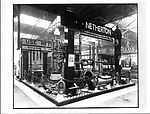 Noah Hingley's exhibition stand
Noah Hingley's exhibition stand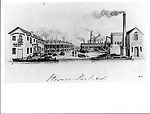 H. Pershouse Parkes Chain Works
H. Pershouse Parkes Chain Works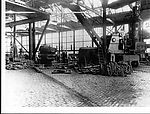 Chain works
Chain works Feel The Heat
Feel The Heat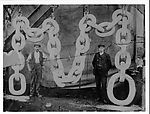 Big chain!
Big chain!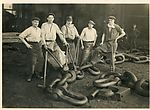 Job Done
Job Done On its way
On its way

For a century or more the Black Country was the global hub of the chainmaking industry. In terms of quality, quantity and variety, the Black Country was recognized as the premier region for the manufacture of a wide range of metal products, including chain.
The success of the chainmaking industry in the Black Country can be attributed to the availability locally of high quality iron and coal. Also, during the late nineteenth century, Britain began its armaments programme in response to German militarisation. This resulted in the building of large numbers of naval vessels and other military equipment, which brought orders to every sector of the economy, particularly the traditional metal trades. During the lead up to the Great War (WWI) the chain and anchor making companies were busy fulfilling orders for the armed forces. Also during this period the shipping lines were engaged in the building of ever larger passenger ships for the transatlantic route, all of which needed chain.
In 1861 it is estimated that over 2800 people were employed in the industry, of which over 500 were women. By 1911 over 6500 people were employed, of which over 2000 were women. There were seventy-seven factories in the Cradley area alone, with a total of 235 in Staffordshire and Worcestershire, including middlemen with their own factories. So from 1861 to 1911 the proportion of women working in the industry had risen from 6% to 32%. This can, perhaps, be accounted for by the fact that the hand made nail making industry, a trade dominated by women homeworkers, was in decline due to mechanisation, and a switch to chainmaking had gradually taken place.
As with the number of people engaged in the trade, there are no records of the amounts of chain produced. An estimate made in 1866 reckoned that 50,000 tons of chains and cables were being produced annually, plus another 10,000 tons for agricultural use. Ninety per cent of the chain made in Britain was made in the Black Country in an area of only two or three square miles around Netherton and Cradley.
One of the principle features of the wrought iron produced in this area was the quality. Wrought iron becomes stronger, more ductile and easier to weld the more it is rolled, so chain used where safety is paramount was rolled three times to produce what was known as “Best Best Chain” for cranes, mines, pulley blocks, ships, rigging and coil chain. Although by the turn of the century the U.S. and Germany had surpassed the U.K. in production of steel, the U.K. remained the world’s leading producer of wrought iron. The quality of the wrought iron chain produced in the Black Country was renowned throughout the world, and a near monopoly was maintained right up to the demise of the industry. The variety of chain produced was extensive, a typical manufacturer offering over 200 different types of chain for a wide range of purposes.
Although those people employed in the smaller factories and the domestic workshops experienced harsh conditions and lifestyle, the larger factories were renowned for their benevolent paternalism. When the Liberal Party returned to power in 1906 a raft of social welfare legislation followed, which firms like N.Hingley and Sons Ltd. were baffled by, as they had provided secure employment and a fair wage. The move to State responsibility for welfare, whilst welcome by those outside the realm of the handful of large manufacturers, was seen by those such as Sir George Hingley as the displacement of an old order in which family, employer and charity exercised a function of care.
Rollover the captions in the box to see the available images in thumbnail format, click the caption to see the full-size image
| Reference: | 667 |
| Keywords: | |
| Archive Ref: | |
| Updated: | Tue 22 May 2007 - 1 |
| Interpretation written by | Louis Howe |
| Author's organisation | Curatorial |
| Organisation's website |